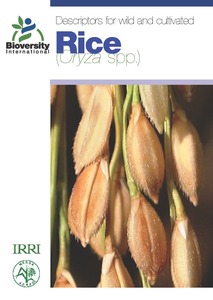Descriptors for wild and cultivated rice (Oryza spp.)
Descriptors for wild and cultivated rice (Oryza spp.)' is a revision of the original IBPGR and IRRI publication 'Descriptors for rice (Oryza sativa L.)' (1980), expanded to include descriptors for wild rice species of the genus Oryza, and harmonized as far as possible with descriptors developed by the International Union for the Protection of New Varieties of Plants (UPOV 2004; www.upov.org) for new cultivars of cultivated rice. The 1980 list has been widely used and is considered to be the most valid descriptor system for rice. This revision has been developed in collaboration with Ruaraidh Sackville Hamilton, Renato Reaño, Socorro Almazan, Elizabeth Naredo, Maria Celeste Banaticla, Edwin Javier and Melissa Fitzgerald of IRRI, and subsequently sent to a number of experts for their comments. A full list of the names and addresses of those involved is given in 'Contributors'. Bioversity International (formerly known as IPGRI) encourages the collecting of data for all five types of descriptors (see Definitions and Use of Descriptors), whereby data from the first four categories - Passport, Management, Environment and Site, and Characterization - should be available for any accession. The number of descriptors selected in each of the categories will depend on the crop and their importance to the crop's description. Descriptors listed under Evaluation allow for a more extensive description of the accession, but generally require replicated trials over a period of time. Although the suggested coding should not be regarded as the definitive scheme, this format represents an important tool for a standardized characterization system and it is promoted by Bioversity throughout the world. This descriptor list provides an international format and thereby produces a universally understood 'language' for plant genetic resources data. The adoption of this scheme for data encoding, or at least the production of a transformation method to convert other schemes into the Bioversity format, will produce a rapid, reliable, and efficient means for information storage, retrieval and communication, and will assist with the use of germplasm. It is recommended, therefore, that information should be produced by closely following the descriptor list with regard to ordering and numbering descriptors, using the descriptors specified and using the descriptor states recommended. This descriptor list is intended to be comprehensive for the descriptors that it contains. This approach assists with the standardization of descriptor definitions. Bioversity does not, however, assume that curators will characterize accessions of their collection using all descriptors given. Descriptors should be used when they are useful to curators for the management and maintenance of the collection and/or to the users of plant genetic resources. However, highly discriminating descriptors are highlighted in the text to facilitate the selection of descriptors and are listed in Annex I. Multicrop passport descriptors were developed jointly by Bioversity and FAO to provide consistent coding schemes for common passport descriptors across crops. They are marked in the text as [MCPD]. Owing to the generic nature of the multicrop passport descriptors, not all descriptor states for a particular descriptor will be relevant to a specific crop. A comparison table of standard colour charts is provided in Annex II for conversion of colour descriptors and Annex III has a table containing cross-references to other documentation systems and their recording stages. Any suggestions for improvement on the 'Descriptors for wild and cultivated rice' will be highly appreciated by Bioversity, IRRI and WARDA.

